Retrograde Intrarenal Surgery (RIRS) is an endoscopic surgery performed to remove renal stones. The procedure is done using a flexible ureteroscope, which is placed through the urethra (the urinary opening) into the bladder and then through the ureter into the kidney (intrarenal area). Through this device, a laser fiber (Holmium laser) is used to treat the stones.
How kidney stones are treated with RIRS?
The ureteroscope has a small camera fitted at its end which is used to inspect the kidney stones. A monitor screen present in the surgery room displays the entire anatomy of the patient’s kidney captured by the ureteroscope. Through an ultrasound wave or a laser probe, the stones are crushed into fine powder or pieces. These fine pieces can pass easily through the urination process.
What are the advantages of RIRS over older techniques like PCNL (Key Hole Surgery)?
RIRS is definitely less invasive than older techniques like PCNL, laparoscopic or open surgery as it is completely scarless. Because we enter the kidney passing through normal urinary tract and there is no need to make any cuts on skin or hole into the kidney (as in PCNL), there is lesser risk of severe bleeding, hospital stay is very short (daycare surgery in most cases), there is markedly shorter period of recovery and patient can very soon get back to his normal routine.
Who can perform RIRS?
RIRS is performed by a urologist (endourologist) with special expertise in RIRS.
What is the advantage of using a high power laser in RIRS?
The best outcome for patients can be given with the use of High power laser. Stone clearance in patients with kidney stones up to 4 cm (staghorn stones) can also be possible only with a high power holmium laser.
Is a stent required to be placed after RIRS? Is it a permanent stent?
Yes, like any other kidney stone surgery, a double J stent is placed in the ureter in most cases of RIRS. The purpose of Double J stent is to keep the ureter open while the laser fragments of stone are washed out and it also decreases the risk of ureteric stricture formation after any intervention. No, Double J stent is only kept temporarily for 2 to 4 weeks and then removed through urethra endoscopically which is a short procedure and the patient can go home the same day after getting it removed.
Can RIRS be used to treat other diseases apart from kidney stones?
Yes, RIRS can be used to treat blockages in the ureter (Strictures/PUJ obstruction), Ureteric and collecting system tumors (for diagnosis as well as treatment).
RIRS is the future of stone surgery. It does require a reasonable amount of experience to master the technique of RIRS but it is immensely beneficial to the patient. At Sarvodaya Hospital, we have a specialized Institute of LASER Urological Surgery equipped with the latest technology and highly advanced Holmium Laser machine to treat several types of complicated kidney stone cases. A patient coming to the hospital with a kidney stone today can walk out of the hospital after surgery the next day itself and soon return to work. The patient has to take a lesser number of days off from work after surgery.










